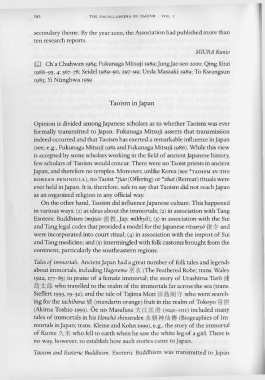Page 232 - The Encyclopedia of Taoism v1_A-L
P. 232
192 THE ENCYCLOPEDIA OP TAOIS M VOL . I
secondary theme. By the year 2000, the Association had published more than
ten research reports.
MIURAKunio
m Ch' a Chuhwan 1984; Fukunaga Mitsuji 1989; JungJae-seo 2000; Qing Xitai
1988-95,4: 567-78; Seidel 1989-90, 297-99; Ueda Masaaki 1989; To Kwangsun
1983; Yi Nunghwa 1959
Taoism in Japan
Opinion is divided among Japanese scholars as to whether Taoism was ever
formally transmitted to Japan. Fukunaga Mitsuji asserts that transmission
indeed occurred and that Taoism has exerted a remarkable influence inJapan
(see, e.g., Fukunaga Mitsuji 1982 and Fukunaga Mitsuji 1986). While this view
is accepted by some scholars working in the field of ancient Japanese history,
few scholars of Taoism would concur. There were no Taoist priests in ancient
Japan, and therefore no temples. Moreover, unlike Korea (see *TAOISM IN THE
KOREAN PENINSULA), no Taoist *jiao (Offering) or *zhai (Retreat) rituals were
ever held in Japan. It is, therefore, safe to say that Taoism did not reachJapan
as an organized religion in any official way.
On the other hand, Taoism did influence Japanese culture. This happened
in various ways: (1) as ideas about the immortals; (2) in association with Tang
Esoteric Buddhism (mijiao Wt5c, Jap. mikkyo); (3) in association with the Sui
and Tang legal codes that provided a model for the Japanese ritsuryo f=It 4- and
were incorporated into court ritual; (4) in association with the import of Sui
and Tang medicine; and (5) intermingled with folk customs brought from the
continent, particularly the southeastern regions.
Tales of immortals. AncientJapan had a great number of folk tales and legends
about immortals, including Hagoromo 3f1;& (The Feathered Robe; trans. Waley
1922, 177-85) in praise of a female immortal; the story of Urashima Tar6 rm
Jib::t. ~~ who travelled to the realm of the immortals far across the sea (trans.
Sieffert 1993, 19-32); and the tale of Tajima Mori EH Jib r"" ~ who went search-
ing for the tachibana ~ (mandarin orange) fruit in the realm of Tokoyo ~·tIt
(Akima Toshio 1993). Oe no Masafusa 7:;. iI ~ m (I041- IIII) included many
tales of immortals in his Honcho shinsenden *~ .ftll1Lll1~ (Biographies of Im-
mortals inJapan; trans. Kleine and Kohn 1999), e.g., the story of the immortal
of Kume ~ * who fell to earth when he saw the white leg of a girl. There is
no way, however, to establish how such stories came to Japan.
Taoism and Esoteric Buddhism. Esoteric Buddhism was transmitted to Japan

